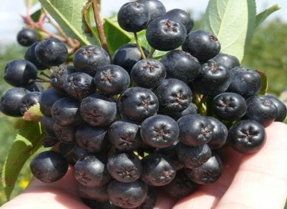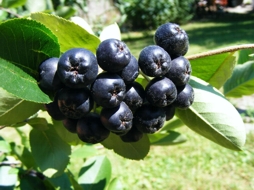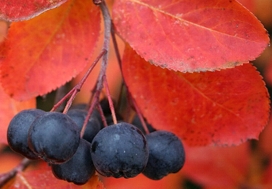| Perennial / Desiduous Trees / Aronia / Black Chokeberry ( Melanocarpa nero ) |
|
|
|
|
| |
|
Plant name - Aronia Melanocarpa
|

|
|
 |
|
 |
| Common name - Black Chokeberry
|
| Plant type - Desiduous / Small Shrub |
| Vegetation type -
Perennial |
| Growth rate - Medium |
| Leaf / Flower color
- Green / White |
| Other names - Chokeberry, Gueles Noires
|
| |
| Description : |
Black Chokeberry is deciduous shrub that grows 3 to 6 feet tall. Black Chokeberry grows as an upright, somewhat rounded shrub that spreads readily by root sprouts. It is tolerant of most soils and climates.
Leaves are glossy, dark green in summer, turning an attractive purple red in the Fall. Flowers are white, 5-petaled clusters, blooming in spring.
Flowers are followed in early Fall by small dark purple, edible fruits. The fruits are high in vitamin C and antioxidants and although edible, are extremely tart and are not for eating fresh but can be used to make tasty jams, jellies, wine, syrup, juice, soft spreads and tea.
The fruits are also eaten by birds and other wildlife.
.
|
| |
| Growing Instructions : |
* After the aronia seeds are stratified, plant them no more than one-quarter inch deep in a container filled with a moist, well-drained germination medium. Cover with glass or plastic and keep the container moist, but not soggy. Aronia seeds should germinate in 3 to 4 weeks at 21 to 25 degrees celsius bottom heat. As soon as the seeds germinate, place them under bright lights or move them to a greenhouse or cold frame.
* For nursery production of seedlings, plant aronia seeds outdoors in well prepared beds in September. If it does not rain, then water the seedbeds before the ground freezes. The seeds will naturally receive cold treatment during the winter. The aronia seeds should start to germinate when the seedbed warms up in the spring.
* Remove all vegetation, rocks and debris from the planting site. Choose a location in full sun or partial shade, though the former is best for flowering and fall color.
* Dig a hole that is twice the width and the same depth as the aronia's root system. Plant the shrub at the same level it was growing before and replace the loosened soil.
* Water until the soil feels very moist. Add a 1- to 3-inch layer of organic mulch but do not allow it to come into contact with the base of the shrub.
* Continue to add moisture any time less than 1 inch of rain falls in a week.
* Fertilize once each spring with a balanced fertilizer.
* Remove suckers that develop around the bottom of the plant. Thin by clipping the weakest branches off all the way back to the ground. Prune as necessary to control the height of the shrub.
|
| |
|
|
|
|
|
